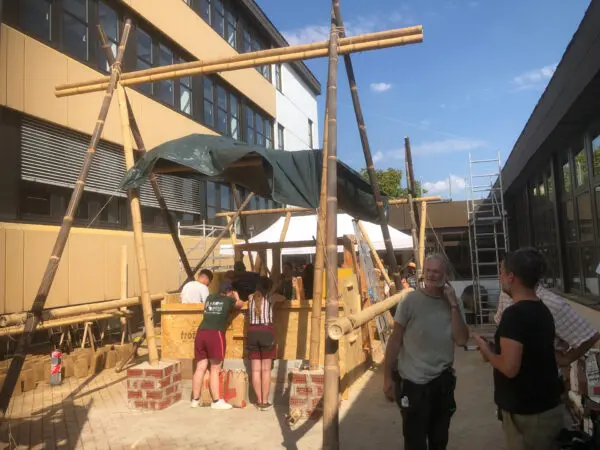
Pisa, Italy
The City and the Water
When:
25 August - 06 September 2025
Credits:
6 EC
Read more
Architecture
When:
20 September - 26 September 2015
School:
University of Ljubljana Faculty of Architecture
Institution:
University of Ljubljana
City:
Country:
Credits:
2 EC
Fee:
360 EUR

Workshop goal
The economic prosperity of the city of Rijeka in the past and in the present is directly related to the functioning of the port. Nowadays people of Rijeka face migration of young people for economic, social and societal reasons. Young people are leaving Rijeka due to stagnation in the development of the city. The latter also significantly affect changes in the city life and the city beat. In this project we want to check vision for the development of the relationship between the port and the city of Rijeka in the border areas between the two urban structures from the perspective of young people. Interconnected areas—or the borders between the city and the port, or the port and the surrounding landscape—are becoming a key point in implementing modern town-planning concepts. Ports fear that urban solutions will affect and restrict the main port activity. Similarly, cities fear that the expansion of the port traffic will generate more noise and negative environmental impacts in city areas.
Themes
Rijeka lacks most of arts and culture, creative industries and education centres. Issues that in this context remain open for discussion are:
- waterfront as a culture destination;
- city workrooms;
- young’ people’s entertainment places;
- interface points between the port and the city;
- port and education;
- port’s warehouses: between the decay and the redevelopment: opportunities for creative renewal.
RESULTS
The results of the project will be used in the future activities planned by the city of Rijeka when applying for European Capital of Culture in 2020. It is similarly expected that the results of the workshop will be used in projects that are acquired by Luka Rijeka to improve the integration of ports in the northern Adriatic, their infrastructure and other links.
WORKSHOP Schedule
Sunday, 20 September 2015 - participants arrive
Monday, 21 September 2015 - field trip and lectures
Tuesday, 22 September 2015 - work
Wednesday, 23 September 2015 - intermediate presentation
Thursday, 24 September 2015 - work
Friday, 25 September 2015 - final presentation
Saturday, 26 September 2015 - participants depart
HELD by University of Ljubljana Faculty of Architecture DAR - Association of Architects Rijeka DUPPS - Town and Spatial Planning Association of Slovenia f.act - forum for gender discourse in art, graz < > gent
The workshop is open to disciplines such as architecture, urban planning and landscpe architecture. We invite students to register for the workshop. The number of students attending the workshop is limited. Your application for the workshop will be valid after it is confirmed by the organizer. After your application is approved, the organizer will take care of food and accommodation reservations. Please e-mail your application to tomaz.bercic@fa.uni-lj.si
Accommodation for students will be reserved by the organizers at boat hotel Marina in Rijeka in the heart of the working area.
RIJEKA AND THE PORT DEVELOPMENT
Until the beginning of the eighteenth century, the city of Rijeka was surrounded by walls and had a population of about 3,000. The first milestone in the urban development of Rijeka is in 1719, when Rijeka became a free port and the population increased fourfold in subsequent years. Another milestone was the establishment of the dual monarchy of Austria–Hungary in 1868, which gave Hungary the opportunity to fulfill its aspirations of building its own port in the Adriatic. In the second half of the nineteenth century, the port of Rijeka developed urban industrial port structures, a railway nexus was formed, and new city quarters developed. In this context, the mouth of the Rječina River was shifted eastward, infilling of the sea in the southern part of the city began, and construction started on the first part of the port breakwater. Hungary managed the construction of the port of Rijeka until the First World War. After the First World War, the port of Rijeka, which became an important European seaport through development supported by Hungary, was divided into two separate ports (the ports of Rijeka and Sušak) corresponding to the city’s division into Rijeka (Ital. Fiume) in Italy and Sušak in Yugoslavia. Consequently, the importance of the geographic location of the port of Rijeka shrank, as well as the throughput at the port. Because of the extended hinterland of the new political formation, the importance of the port of Sušak grew. Some years before the beginning of the Second World War, the amount of throughput was almost equal between the ports of Rijeka and Sušak, but the general throughput was still significantly lower than the throughput at the port of Rijeka before the First World War. After the Second World War, Rijeka and Sušak were reunited as both an urban structure and port.
In Rijeka, wartime destruction disabled both ports from April 17th until May 3rd, 1945. “ All of the docks and quays, the port’s facilities, the storehouses, and the railway and traffic routes in the harbor were mined and demolished. Only 904 meters of the total length of the operative coastline of 8,056 meters and three of the forty derricks remained undestroyed.” The Paris Peace Treaty of 1947 awarded Rijeka to Yugoslavia. After that, intensive reconstruction of the port began, and soon (1949) the throughput at the port of Rijeka surpassed the highest historical records of goods traffic in 1913. The period after the Second World War saw the most dynamic development of the port of Rijeka. In the 1980s, the port of Rijeka accounted for 50% of the traffic of all Yugoslav ports and it was the most important Yugoslav port. The capacities of the port could not meet the strong increase in port traffic (e.g., maintaining around fifty lines to almost all important international ports). Consequently, new spatially dispersed port basins were built; the terminal for bulk cargo in Bakar–Urinj, a port basin with a terminal for the Adriatic Oil Pipeline in Omišalj, the Raša port basin for loading timber, and a terminal for livestock. There were more changes at the port of Sušak, where a container terminal was opened at Brajdica in 1978 after infilling. The port of Rijeka became the main national port after Croatia proclaimed its independence. However, although the overall port traffic exceeded 20 million tons in 1980, it only amounted to 4.6 million tons four years ago, which is comparable with throughput after the 1960s.
The port of Rijeka is located between the city and the sea, and its quays are long, but they lack storage and handling areas. In the physical sense, the port grew along the coast.
Fee
360 EUR, The registration fee covers all workshop costs except travelling to and from Rijeka: accomodation, working rooms, three meals a day, a visiting trip.
When:
20 September - 26 September 2015
School:
University of Ljubljana Faculty of Architecture
Institution:
University of Ljubljana
Credits:
2 EC

Pisa, Italy
When:
25 August - 06 September 2025
Credits:
6 EC
Read more

Wiesbaden, Germany
When:
11 August - 16 August 2025
Credits:
4 EC
Read more

Berlin, Germany
When:
30 July - 07 August 2025
Credits:
1 EC
Read more